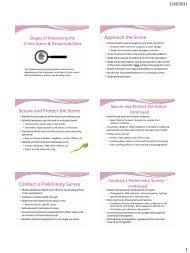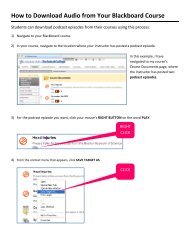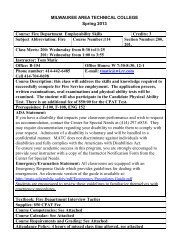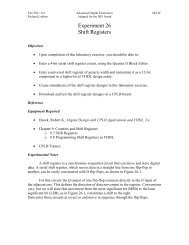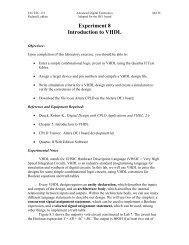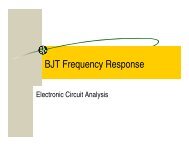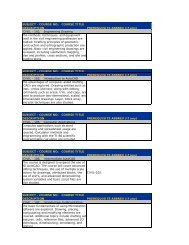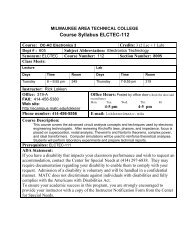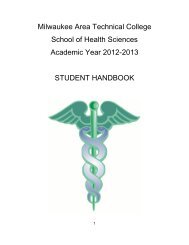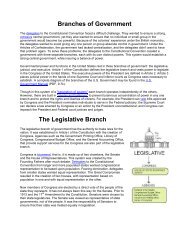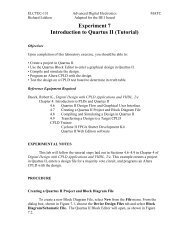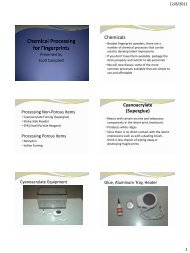WI Forward Award 2012 - Welcome to MATC - Milwaukee Area ...
WI Forward Award 2012 - Welcome to MATC - Milwaukee Area ...
WI Forward Award 2012 - Welcome to MATC - Milwaukee Area ...
Create successful ePaper yourself
Turn your PDF publications into a flip-book with our unique Google optimized e-Paper software.
Cus<strong>to</strong>mer Focus: Category 3<br />
Finally, the increased number of conditionally admitted students<br />
continues <strong>to</strong> be a challenge. However, a new College Success<br />
Course has proven <strong>to</strong> be a successful intervention strategy for<br />
these high-risk students. For example, a fall 2010 assessment<br />
found higher average term GPAs for students of all racial groups<br />
successfully completing the college success course compared <strong>to</strong><br />
their counterparts. At this time, the course is not manda<strong>to</strong>ry, but<br />
the CLA Core Committee is examining that possibility through<br />
research reviews.<br />
3.2.a(3) Student and Stakeholder Segmentation<br />
While the college responds <strong>to</strong> needs systematically, it also<br />
remains adaptable in order <strong>to</strong> respond and anticipate program<br />
and service needs. While some processes are methodically<br />
reviewed and revised, <strong>MATC</strong> can also react immediately, such<br />
as partnership needs reflected in a CBO community survey<br />
conducted in 2010 that resulted in adding GED courses <strong>to</strong> some<br />
of these locations (Figure 7-4f). <strong>MATC</strong> uses a variety of measures<br />
<strong>to</strong> scan and forecast student and stakeholder needs. The “check”<br />
phase of <strong>MATC</strong>’s PDCA cycle includes: a SWOT analysis;<br />
the environmental scans; KPIs; recommendations from core<br />
committees; assessments of internal and external stakeholders’<br />
needs, and an evaluation of the current seven-year plan.<br />
Another process <strong>to</strong> identify student needs results from<br />
collaborative work among the Communications and Events<br />
Department, IRSP, and the Student Services Division. The SEM<br />
Core Committee and the Enrollment and Capacity team also<br />
play pivotal roles. The Enrollment and Capacity Team meets<br />
regularly, before and during each semester, <strong>to</strong> address the range<br />
of curriculum, processing, marketing, and recruitment challenges<br />
reflected trends in weekly enrollment reports. This process<br />
seeks <strong>to</strong> maximize the recruitment, admission, marketing,<br />
retention, graduation, employment and transfer of students by<br />
discussing data-informed trends <strong>to</strong> target key student segments.<br />
The following are current segments tracked through the Student<br />
Services Data Warehouse (SSDW) and online Enrollment<br />
Funnel reports: Smart Start prospects; applicants; new,<br />
returning and continuing students; and students by age, race,<br />
campus, program and division/school. Community stakeholder<br />
groups have been identified and are being prioritized through<br />
a continuing improvement project of the Collaborations and<br />
Partnerships Core Committee in <strong>2012</strong>.<br />
3.2.a(4) Student and Stakeholder Data Use<br />
A weekly report tracks trends in enrollments by student segment.<br />
It is reviewed at the President’s Cabinet meetings as well at<br />
regular Enrollment and Capacity Team meetings. Actions are<br />
taken by admissions, recruitment, scheduling and marketing<br />
staff as well as deans and associate deans in reaction <strong>to</strong><br />
discussions.<br />
Students, faculty and staff participated in a focus group when<br />
the college contracted with a new advertising agency. Staff and<br />
agency representatives received feedback and revised collateral<br />
materials <strong>to</strong> incorporate suggestions. Messages from other<br />
local colleges and universities are moni<strong>to</strong>red <strong>to</strong> ensure <strong>MATC</strong>’s<br />
messages help distinguish the college from our competi<strong>to</strong>rs.<br />
Community perception surveys act as benchmarks for change as<br />
well. When purchasing media time and space, <strong>MATC</strong> assesses<br />
their distinct audiences. For example, the radio stations and time<br />
of day purchased for advertising <strong>to</strong> reach prospective students<br />
is very different than what is purchased when trying <strong>to</strong> reach<br />
members of the local business community. Additionally, the<br />
Communications and Events Department uses social media <strong>to</strong><br />
reach prospective students, recognizing that using traditional<br />
media sources may not be as successful.<br />
Figure 3-2b: Student Populations & Sample Support Services<br />
Student Group<br />
Academically Disadvantaged Students<br />
Displaced Homemakers<br />
Economically Disadvantaged Students<br />
Limited-English Proficiency Students<br />
Non-Traditional Occupation Students (NTO)<br />
Students with Migrant<br />
and/or Seasonal Farm Worker Background<br />
Program Students<br />
Single Parents<br />
Students with Disabilities<br />
Veterans<br />
Examples of Support Services Provided<br />
Basic Skills, General Education and High School Equivalency assistance and testing,<br />
Adult High School, Prepared-Learner Initiative, Tu<strong>to</strong>ring, Men<strong>to</strong>ring, Academic Support Centers<br />
Individualized counseling, workshops, career exploration; academic support<br />
Financial aid; scholarship opportunities; Application Fee Waiver<br />
Multicultural Services; English as a Second Language programs; ongoing case management;<br />
tu<strong>to</strong>ring; academic support; bilingual programs; bilingual courses<br />
NTO Office; career planning; course advising; access <strong>to</strong> student services<br />
College Assistance Migrant Program (CAMP); High School Equivalency Program (HEP);<br />
assistance with first-year tuition cost; academic tu<strong>to</strong>ring; career counseling<br />
Academic Support Centers; academic tu<strong>to</strong>ring, men<strong>to</strong>ring, and writing assistance<br />
through the Online Writing Lab (OWL); counseling services<br />
Day Care (affordable child care at all four campuses); financial aid and scholarship options<br />
Student Accommodation Services; one-on-one support with Disability Specialists; Adaptive/Assistive Technology; assistance<br />
with course selection; closed-captioned TVs; computers with enlarged text; note-taking accommodations; sign language<br />
interpreting; tape recording of lectures; test accommodations; text conversion in<strong>to</strong> alternate formats<br />
Veterans Affairs Office; Vets Club; connect Veterans <strong>to</strong> County Veterans Services; help establish priority readmission<br />
for veterans; help secure 100% refund of all tuition and fees <strong>to</strong> students who are ordered or inducted in<strong>to</strong> active service;<br />
publicize veteran’s events<br />
17



